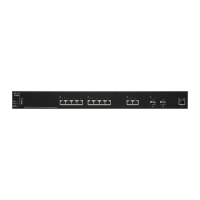IP Configuration
IPv6 Management and Interfaces
287 Cisco Sx350, SG350X, SG350XG, Sx550X & SG550XG Series Managed Switches, Firmware Release 2.2.5.x
15
IPv6 Management and Interfaces
This section covers the following topics:
•Overview
• IPv6 Global Configuration
• IPv6 Interfaces
•IPv6 Tunnel
• IPv6 Addresses
• IPv6 Router Configuration
• IPv6 Default Router List
• IPv6 Neighbors
• IPv6 Prefix List
• IPv6 Access Lists<350-550>
• IPv6 Routes
• DHCPv6 Relay<350-550>
Overview
The Internet Protocol version 6 (IPv6) is a network-layer protocol for packet-switched
internetworks. IPv6 was designed to replace IPv4, the predominantly deployed Internet
protocol.
IPv6 introduces greater flexibility in assigning IP addresses, because the address size increases
from 32-bit to 128-bit addresses. IPv6 addresses are written as eight groups of four
hexadecimal digits, for example FE80:0000:0000:0000:0000:9C00:876A:130B. The
abbreviated form, in which a group of zeroes can be left out, and replaced with '::', is also
acceptable, for example, FE80::9C00:876A:130B.
IPv6 nodes require an intermediary mapping mechanism to communicate with other IPv6
nodes over an IPv4-only network. This mechanism, called a tunnel, enables IPv6-only hosts to
reach IPv4 services, and enables isolated IPv6 hosts and networks to reach an IPv6 node over
the IPv4 infrastructure.

